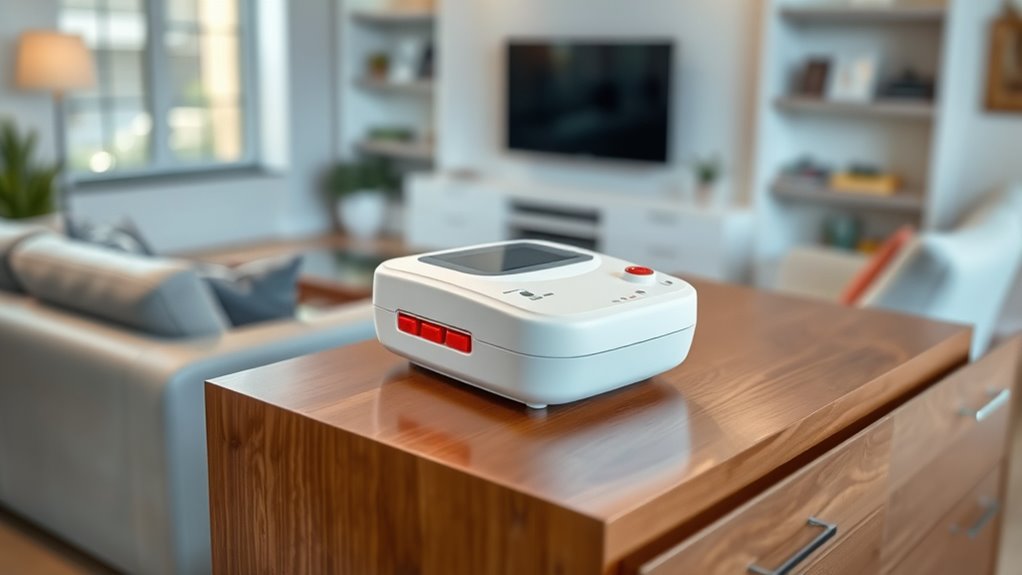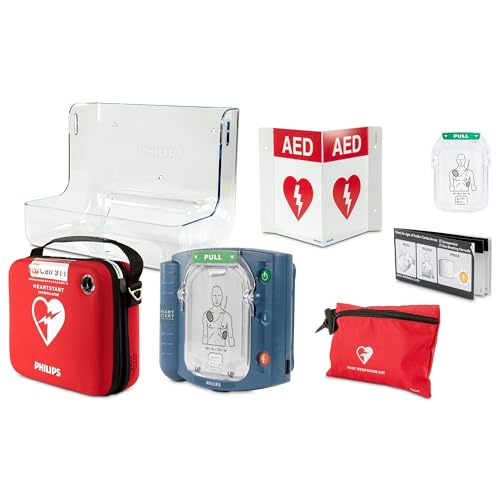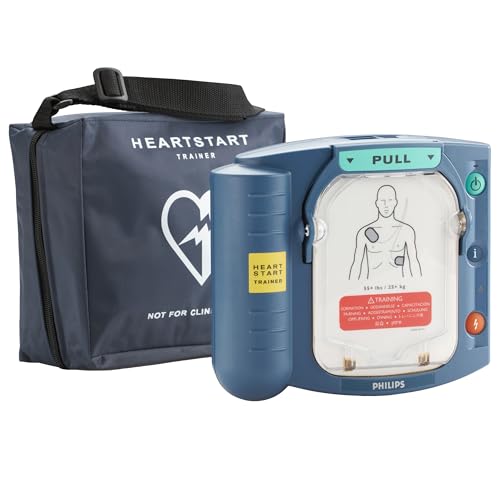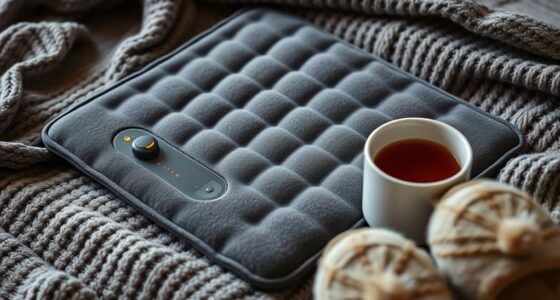If you’re looking to protect your loved ones with confidence, choosing the right home defibrillator is essential. I recommend user-friendly models like the Philips HeartStart OnSite AED or portable units with quick shock delivery and clear voice prompts. Consider devices with automatic self-tests, safety features, and easy storage options. I’ll guide you through the top 15 options for 2025 so you can make an informed decision and guarantee you’re prepared for emergencies.
Key Takeaways
- Top home defibrillators feature user-friendly voice prompts, visual instructions, and rapid shock delivery within seconds.
- Compact, lightweight designs with easy access options like wall mounts and carry cases ensure quick response.
- Regular self-tests and automatic maintenance routines guarantee device readiness and reliability.
- Compatibility with adult and pediatric pads, along with training accessories, enhances emergency preparedness.
- Leading models offer safety features, clear indicators, and simple operation suitable for untrained users in emergencies.
Philips HeartStart OnSite AED Defibrillator, OnSite Ready-Pack M5066A-R01
If you’re looking for a reliable and easy-to-use defibrillator for home or small environment emergencies, the Philips HeartStart OnSite AED is an excellent choice. It’s portable, with a compact carry case that includes spare pads and a cartridge, making it perfect for quick access in various settings. The device features real-time CPR guidance, step-by-step voice prompts, and advanced SMART Analysis technology to assess heart rhythms accurately. It can deliver a shock within 8 seconds after analysis, with self-tests to guarantee readiness. Designed for intuitive use, it requires no prior training, making it an ideal option for families seeking peace of mind.
Best For: families, small businesses, and public venues seeking a portable, easy-to-use defibrillator with automatic self-testing and real-time guidance.
Pros:
- User-friendly operation with step-by-step voice prompts and CPR guidance
- Compact design with pre-installed spare pads and accessories for quick deployment
- Regular self-tests ensure device readiness without manual calibration
Cons:
- Limited to adult use unless additional infant/child training pads are purchased separately
- Battery and pads are warrantied only until their expiration date, requiring replacements over time
- May not include advanced features found in higher-end AED models, suitable mainly for basic emergency use
AED Trainer & AED Simulator for Home and First Aid Training
The AED Trainer & Simulator (XFT-120N) is an ideal choice for home users and first aid beginners who want a safe, easy-to-use device for CPR and AED practice. It’s lightweight and portable, designed specifically for training, not real defibrillation, ensuring safety. It offers multiple modes including semi- and full-auto, scenario simulation, and CPR feedback, with customizable settings like language and volume. Real-time voice prompts guide users through realistic emergency scenarios, boosting confidence and understanding. Compatible with most AED training mannequins, it comes with essential accessories and saves configurations for consistent sessions. This device makes first aid training accessible and effective at home.
Best For: home users and first aid beginners seeking a safe, portable AED and CPR training device with realistic scenario simulation.
Pros:
- User-friendly with real-time voice prompts to guide training
- Supports multiple training modes including semi- and full-auto, CPR feedback, and scenario simulation
- Compatible with most AED training mannequins and includes essential accessories
Cons:
- Not suitable for actual defibrillation or medical emergencies
- Limited to training scenarios; cannot replace professional AED equipment
- May require familiarity with device settings for optimal use
AliveCor KardiaMobile 6-Lead Personal EKG Monitor
The AliveCor KardiaMobile 6-Lead Personal EKG Monitor is ideal for individuals who want detailed, medical-grade heart data at home without the need for bulky equipment. It provides six-lead ECG recordings in just 30 seconds, detecting AFib, Bradycardia, Tachycardia, and Normal Sinus Rhythm. Compatible with most smartphones and tablets via the Kardia app, it requires no subscription for basic use. FDA-cleared and trusted by doctors, it offers six times the data of single-lead devices, enhancing accuracy. Lightweight and portable, it’s easy to use, making it a reliable tool for monitoring your heart health and sharing data with healthcare providers.
Best For: individuals seeking a portable, medical-grade ECG device for regular heart monitoring at home without the need for complex equipment.
Pros:
- Provides six-lead, medical-grade ECG recordings in just 30 seconds for detailed heart data
- Compatible with most smartphones and tablets via the free Kardia app, no subscription required for basic features
- FDA-cleared, trusted by healthcare professionals, and lightweight for easy portability
Cons:
- Not suitable for use with pacemakers or implantable cardioverter defibrillators (ICDs)
- Does not detect heart attacks, only arrhythmias and rhythm issues
- Requires a smartphone or tablet for operation, which may limit use in some settings
Philips HeartStart AED Defibrillator Adult SMART Pads Cartridge, M5071A
Designed specifically for adult suspected cardiac arrest patients weighing 55 lbs or more, the Philips HeartStart AED Defibrillator Adult SMART Pads Cartridge, M5071A, offers quick and easy access during emergencies. It’s compatible with Philips Home and OnSite AEDs, containing self-adhesive pads with an attached cable that are virtually ready to use once installed. The pull handle allows rapid retrieval, ensuring prompt response when seconds matter. This cartridge simplifies emergency preparedness, with Philips’s trusted reliability. Keep a spare on hand for seamless replacement, and contact Philips directly for any performance questions. With this cartridge, you can confidently deliver life-saving shocks when every second counts.
Best For: individuals and organizations seeking a reliable, easy-to-use adult AED pads cartridge compatible with Philips HeartStart AEDs for emergency cardiac arrest situations.
Pros:
- Quick and easy access with pull handle for rapid deployment during emergencies
- Compatible with Philips Home and OnSite AEDs, ensuring versatility
- Contains self-adhesive pads with attached cable, ready for immediate use
Cons:
- Limited to use with Philips AED models, requiring specific compatibility
- Replacement is only recommended for warranty purposes, not routine updates
- May require professional guidance for correct installation and operation
Portable AED Defibrillator for Home Use
A portable AED defibrillator is an excellent choice for homeowners who want quick, reliable access to life-saving technology during emergencies. These devices are designed for ease of use, with automatic operation that guides you through each step. Before using, I recommend inspecting the unit for signs of damage or wear and avoiding it if parts are compromised. It’s important to keep the device dry and clean—just a gentle wipe with a damp cloth will do. Remember, using it within the manufacturer’s specifications is essential for safety and effectiveness. Regular checks ensure your AED is ready to save a life when seconds count.
Best For: homeowners seeking a reliable, easy-to-use emergency defibrillator to ensure immediate response during cardiac emergencies.
Pros:
- Compact and portable design for convenient home use
- Automatic operation with clear guidance enhances user confidence
- Easy to clean and maintain with simple wiping instructions
Cons:
- Requires regular inspection to ensure it’s free of damage or wear
- Not suitable for use if parts are damaged or if exposed to liquids
- Modifications outside manufacturer specifications may cause malfunctions
Philips HeartStart OnSite AED Defibrillator
If you’re looking for a reliable and easy-to-use defibrillator for your home or small business, the Philips HeartStart OnSite AED stands out because it offers step-by-step voice prompts and real-time CPR guidance that even first-time users can follow confidently. Its SMART Analysis technology evaluates heart rhythms quickly, enabling fast shock delivery within 8 seconds when needed. The device performs regular self-tests to guarantee readiness, and its versatility allows use on wet or metal surfaces. With accessories like training pads and a thorough carry case, it’s designed for quick, safe response in emergencies, making it an excellent choice for any public or private setting.
Best For: individuals, small businesses, and public spaces seeking a reliable, easy-to-use AED with clear guidance for emergency situations.
Pros:
- User-friendly with step-by-step voice prompts suitable for first-time users
- Rapid shock delivery within 8 seconds, thanks to SMART Analysis technology
- Performs regular self-tests to ensure device readiness without manual calibration
Cons:
- Accessories like training pads and extra batteries are sold separately, increasing overall cost
- Limited to warranty-replacement for parts; no non-warranty replacements available
- May require familiarity with the device’s operation for optimal use in high-stress situations
Philips HeartStart Home AED Defibrillator
The Philips HeartStart Home AED Defibrillator stands out as an ideal choice for homeowners and residents seeking a reliable, easy-to-use device in emergencies. It offers real-time CPR guidance with clear voice prompts and adapts to your pace using SMART Pads. The device is nearly ready to use, requiring no prior training, and performs regular self-tests to guarantee it’s always prepared. Its quick shock feature delivers therapy within 8 seconds, making it highly effective. Designed for use on wet or metal surfaces, it’s safe and dependable. With comprehensive accessories and support, this AED provides peace of mind, enabling confident, immediate response when every second counts.
Best For: Homeowners and residents seeking an easy-to-use, reliable AED for rapid response during sudden cardiac emergencies.
Pros:
- Provides real-time CPR guidance with adaptive voice prompts for user-friendly operation
- Delivers therapy within 8 seconds with Quick Shock technology for rapid treatment
- Performs automatic self-tests to ensure device readiness without manual calibration
Cons:
- Requires purchase of optional training pads for simulation and training scenarios
- Limited to home and residence use; not designed for professional or outdoor emergency settings
- Battery and pads have expiration dates, necessitating regular replacements to maintain readiness
Philips HeartStart Home AED Defibrillator, Value Package M5068A-C04
Looking for a reliable, easy-to-use defibrillator for home emergencies? The Philips HeartStart Home AED Defibrillator, Value Package M5068A-C04, is designed for simplicity and quick response. It’s portable, with clear voice prompts and real-time CPR instructions, so no training is needed. The device uses advanced SMART Analysis technology to assess heart rhythms and delivers a shock within 8 seconds if necessary. It performs regular self-tests to stay ready, and the package includes everything you need—batteries, pads, a wall mount, and training materials. With an 8-year warranty, this AED offers peace of mind for any household.
Best For: households or private residences seeking a simple, reliable, and emergency-ready AED with no prior training required.
Pros:
- User-friendly with clear voice prompts and real-time CPR guidance.
- Equipped with advanced SMART Analysis technology for rapid shock delivery within 8 seconds.
- Comes with a comprehensive kit including batteries, pads, wall mount, and training materials, plus an 8-year warranty.
Cons:
- Limited to home or non-professional use; not suitable for professional medical settings.
- Accessories like training pads are sold separately, which may increase overall cost.
- Regular self-tests are built-in but require users to ensure the device remains properly maintained and charged.
Philips HeartStart OnSite AED Defibrillator, Business Package M5066A-C02BPB
The Philips HeartStart OnSite AED Defibrillator Business Package M5066A-C02BPB is an excellent choice for public settings where quick, reliable emergency response is critical, especially since it’s designed for ease of use by untrained individuals. This portable device offers real-time CPR guidance with voice prompts and visual instructions, making it accessible even for first-time responders. It features SMART Analysis technology for accurate rhythm assessment and delivers a shock within 8 seconds if needed. The package includes everything you need—batteries, pads, a sturdy case, and signage—plus regular self-tests guarantee readiness. It’s a dependable, user-friendly solution for any public environment.
Best For: public places like restaurants, offices, gyms, airports, and businesses seeking a reliable, easy-to-use AED for suspected sudden cardiac arrest emergencies.
Pros:
- User-friendly with step-by-step voice prompts and visual instructions suitable for untrained responders
- Rapid shock delivery within 8 seconds with SMART Analysis technology ensures timely treatment
- Regular self-tests maintain device readiness without manual calibration
Cons:
- Requires separate purchase of training pads for practice or training purposes
- Limited to adult use unless converted with additional training pads cartridges
- The device and accessories may represent a significant initial investment for smaller organizations
AED Trainer & AED Simulator for Home and First Aid Practice
If you’re new to first aid or want a safe, effective way to practice AED use at home, an AED trainer and simulator like the XFT-120N is an excellent choice. It’s lightweight, portable, and designed specifically for beginners, offering realistic training without the risk of actual defibrillation. The device supports semi and full auto modes, scenario simulation, and CPR practice with adjustable settings. Real-time voice prompts guide you step-by-step, boosting confidence and understanding. Compatible with most AED training manikins and available in multiple languages, the XFT-120N makes first aid training accessible and effective, helping you prepare to save lives confidently.
Best For: beginners and home users seeking a safe, realistic, and easy-to-use AED training device to build confidence in emergency first aid situations.
Pros:
- Lightweight and portable, ideal for home use and easy transport
- Supports multiple training modes and realistic emergency scenarios aligned with latest guidelines
- Voice prompts and feedback enhance understanding and confidence during training
Cons:
- Cannot deliver actual defibrillation for real medical emergencies
- Limited to training purposes, not suitable for clinical or professional use
- May require additional AED training accessories for comprehensive practice
Philips HeartStart AED Defibrillator with Emergency Medical Kit
The Philips HeartStart AED Defibrillator with Emergency Medical Kit is an ideal choice for homeowners who want a reliable, easy-to-use device in case of sudden cardiac arrest. It features real-time CPR guidance, step-by-step voice prompts, and requires no prior training. The device uses advanced SMART Analysis technology to assess heart rhythms quickly, delivering a shock within 8 seconds if needed. It performs regular self-tests to stay ready and includes accessories like a carry case, spare pads, and a quick response kit. With an 8-year warranty and user-friendly design, this AED empowers you to act confidently in emergencies.
Best For: homeowners and untrained responders seeking a reliable, easy-to-use AED for emergency situations involving sudden cardiac arrest.
Pros:
- User-friendly with step-by-step voice prompts and real-time CPR guidance.
- Advanced SMART Analysis technology ensures accurate rhythm assessment and quick shock delivery.
- Regular self-tests and an 8-year warranty provide confidence in device readiness and durability.
Cons:
- Optional training pads for simulation are sold separately, which may incur additional costs.
- The device is primarily designed for home use and may lack advanced features found in professional-grade AEDs.
- Limited to adult use unless converted with infant/child training accessories, which are sold separately.
Philips HeartStart AED Trainer with Carry Case
Designed specifically for responders and training programs, the Philips HeartStart AED Trainer with Carry Case offers a realistic and safe way to practice life-saving skills. It simulates real AED operation, guiding users through scenarios with voice prompts that match actual HeartStart AEDs. The trainer supports both adult and child/infant CPR, making it versatile for different training needs. Included are reusable training pads, an external manikin adapter, and a convenient carry case. Remember, this device is strictly for training—never for use in real emergencies. It’s a reliable tool to build confidence and ensure responders are prepared to save a life when it counts.
Best For: responders and training programs seeking a realistic, safe AED training device to build confidence and proficiency in life-saving skills.
Pros:
- Provides realistic voice prompts identical to actual HeartStart AEDs for authentic training experience
- Supports both adult and child/infant CPR scenarios for versatile training needs
- Includes reusable training pads, external manikin adapter, and carry case for convenience and durability
Cons:
- Designed solely for training; cannot be used in real emergency situations
- Child/infant training pads are sold separately, requiring additional purchase for pediatric training
- Limited to preconfigured scenarios, which may not cover all emergency variations
M5070A AED Battery Replacement for Philips AED Defibrillator
The M5070A AED battery replacement is an essential component for those who own Philips AED models HS1 or FRX and want to make certain their device is always ready for emergencies. This 9V 4.2Ah high-capacity battery is designed specifically for over-the-counter home AED devices, ensuring quick and reliable defibrillation when needed. It offers a lifespan of up to five years from the manufacturing date, providing peace of mind for long-term emergency preparedness. The replacement process is simple with its user-friendly design, making it easy to install. Proper maintenance of this battery guarantees your Philips AED remains dependable, ensuring you’re prepared to save a life anytime an emergency occurs.
Best For: Homeowners, first responders, and medical professionals seeking a reliable replacement battery for Philips AED HS1 and FRX models to ensure device readiness in emergencies.
Pros:
- Compatible with multiple Philips AED models, including HS1 and FRX.
- Long-lasting with a lifespan of up to five years from manufacturing date.
- Easy to install and replace, facilitating quick maintenance.
Cons:
- Only suitable for specific Philips AED models, limiting versatility.
- Requires proper storage to maintain battery integrity over time.
- May need periodic replacement after five years to ensure optimal performance.
All-in-One AED Cabinet Kit
If you’re looking for a reliable way to store and protect an AED at home or in the office, the All-in-One AED Cabinet Kit is an excellent choice. It’s a sturdy, wall-mounted steel box compatible with all AED models, featuring clear signage and a transparent window for quick access. The secure snaplock prevents unauthorized use, while an optional alarm alerts nearby when opened, deterring theft and tampering. Easy to install and built from durable materials, this kit includes inspection tags, seals, and signage to guarantee maintenance and compliance. It’s a practical solution for safeguarding your AED and ensuring readiness in emergencies.
Best For: homes and offices seeking a secure, durable, and easily accessible storage solution for AEDs to ensure safety and compliance.
Pros:
- Compatible with all AED models, offering versatile use across different environments.
- Features a transparent window and bright signage for quick identification and access during emergencies.
- Includes security measures such as snaplock, seals, and optional alarm to prevent tampering and theft.
Cons:
- Assembly is required, which may be inconvenient for some users.
- No customization options available for specific needs or preferences.
- The product does not include an AED, requiring separate purchase.
Philips HeartStart Home and Onsite Automated External Defibrillator Battery
For those who want to guarantee their AED is always ready, the Philips HeartStart Home and Onsite AED Battery offers a reliable, long-lasting power backup. Designed as a disposable lithium manganese dioxide battery, it ensures your device stays operational for up to four years after installation, with a shelf life of five years. It’s easy to install—just click it in without tools—making maintenance simple. Keep spare batteries on hand, especially if you use your AED frequently for training or demonstrations. Using original Philips batteries guarantees compatibility and quick access during emergencies, so you can feel confident your AED will perform when every second counts.
Best For: individuals and organizations seeking a reliable, long-lasting backup battery to ensure their Philips HeartStart AED is always ready for emergency use.
Pros:
- Long shelf life of five years and operational lifespan of four years after installation
- Easy to install with a tool-free, click-in design
- Compatible exclusively with Philips HeartStart AED models for guaranteed performance
Cons:
- Replacement is only permitted for warranty purposes
- Requires careful storage and inventory management for frequent training use
- Limited to use with Philips HeartStart AED units, not interchangeable with other brands
Factors to Consider When Choosing Defibrillators for Home Use

When selecting a defibrillator for home use, I consider how easy it is to operate and whether it provides clear emergency guidance. I also evaluate the device’s reliability and safety features to guarantee it functions properly when needed. Additionally, I look into maintenance needs to keep the unit ready and accessible at all times.
Ease of Operation
Choosing a defibrillator for home use means prioritizing ease of operation so that anyone can use it effectively in an emergency. Clear voice prompts and visual instructions are essential, guiding users step-by-step through the rescue process. Devices with intuitive interfaces require minimal training, allowing untrained individuals to respond quickly. Automated features, like voice-guided CPR and automatic rhythm analysis, simplify operation and help reduce errors. A lightweight, portable design ensures fast access when every second counts. User-friendly models also include safety prompts, such as pad placement guidance and shock confirmation, to ensure correct use. Prioritizing ease of operation means you can act confidently, even under pressure, increasing the chances of saving a loved one’s life during a sudden cardiac emergency.
Device Reliability
Reliability is vital when selecting a home defibrillator, as you want to be confident it will work correctly during an emergency. I look for devices that perform regular self-tests, catching potential issues before they matter most. Advanced analysis technology helps guarantee the device accurately assesses heart rhythms, reducing false shocks and delivering proper therapy. Durable build quality and sturdy components are essential, minimizing the risk of failure when seconds count. Clear voice and visual prompts boost user confidence, guiding me through each step and reducing errors. Long-lasting batteries and pads with warranties until their expiration dates mean I can trust the device to function when needed. Overall, dependable defibrillators are designed to be trustworthy, giving me peace of mind that I’m prepared for an emergency.
Safety Features
Safety features are crucial for ensuring that a home defibrillator can be used confidently and correctly during an emergency. I look for devices with built-in safety measures like shock delivery confirmation, which helps prevent accidental shocks. Clear voice prompts and visual instructions are essential—they guide users step-by-step, reducing confusion. Automatic self-tests are also important because they verify the device’s readiness regularly, so you’re not caught off guard. Easy-to-access pads and components prevent misuse or accidental activation, ensuring safety during urgent moments. Additionally, protective covers or tamper-evident seals safeguard against unauthorized access or damage. These features collectively boost user confidence and make sure the device functions correctly when every second counts. Safety features are truly the backbone of a reliable home defibrillator.
Maintenance Requirements
Regular maintenance is essential to guarantee your home defibrillator is always ready to use when needed. I recommend inspecting the device regularly for any signs of damage, wear, or missing parts before use. Check the battery and pads to ensure they’re within their expiration dates and replace them promptly if needed. Following the manufacturer’s guidelines, perform scheduled self-tests or maintenance checks to confirm the device’s readiness. Keep spare batteries and pads nearby so you can quickly swap them out if they expire or are used during an emergency. Additionally, clean the device with a damp, lint-free cloth to maintain hygiene and functionality. Avoid submerging or exposing it to liquids, as moisture can damage the electronics. Proper upkeep guarantees your defibrillator is reliable and ready whenever you need it.
Emergency Guidance
When selecting a home defibrillator, it’s important to contemplate how well it can guide users through an emergency. A good device provides clear, step-by-step voice and visual prompts, helping even untrained users respond confidently. Features like real-time CPR instructions and prompts for shock delivery can substantially reduce response times and boost survival chances. Automated analysis technology is essential; it assesses heart rhythms accurately and determines if a shock is needed, preventing unnecessary interventions. User-friendly interfaces and intuitive instructions ensure that non-medical personnel can operate the device under stress. Additionally, training and simulation modes, like AED trainers, can enhance preparedness by allowing safe practice without risking patient safety. These guidance features are critical for effective, confident emergency responses at home.
Battery Life Span
A key factor in choosing a home defibrillator is its battery life span, as it determines whether the device will be ready when you need it most. Longer battery life means the defibrillator can stay operational and reliable over extended periods without frequent replacements. Most home-use models feature batteries with a 5-year shelf life and a 4-year operational lifespan, ensuring consistent readiness. Regularly checking or replacing batteries before they expire is essential to maintain functionality. High-capacity batteries reduce the risk of failure during critical moments, providing peace of mind. Always use manufacturer-recommended batteries to guarantee compatibility, safety, and peak performance. Prioritizing battery life span helps ensure your device is dependable when every second counts in an emergency.
Portability and Storage
Choosing a defibrillator that’s easy to carry and store can make a significant difference in an emergency. A compact, lightweight design allows you to quickly move and position the device when needed, which is essential during a critical situation. Storage cases with secure closures protect the device from dust, moisture, and accidental damage while keeping it accessible. Wall-mounted cabinets with clear signage and transparent windows enable fast access and visual confirmation of readiness, saving precious seconds. Battery life and ease of replacement are crucial for maintaining portability without frequent maintenance, especially at home. Additionally, features like a carry handle or strap make transportation more convenient. Prioritizing portability and proper storage ensures your defibrillator is ready to perform when every second counts.
Cost and Warranty
Are you aware of how the cost and warranty coverage can influence your long-term investment in a home defibrillator? The initial price varies, so it’s important to choose one that fits your budget without sacrificing quality. Look for devices with longer warranties, like 8 years, which show confidence in their durability. Check if the battery and pads are covered under warranty until their expiration date to avoid unexpected expenses. Review the warranty’s terms carefully to understand what damages or malfunctions are included and whether maintenance is required. Additionally, consider the cost and availability of replacement parts or accessories, as these can add up over time. Balancing affordability with extensive coverage ensures your device remains reliable when you need it most.
Frequently Asked Questions
How Long Does a Fully Charged Home Defibrillator Last?
A fully charged home defibrillator typically lasts about 3 to 5 years before needing a battery replacement. The exact lifespan depends on the model and usage. I always check the device regularly and replace the batteries as recommended by the manufacturer to guarantee it’s ready when needed. Keeping it well-maintained gives me confidence that I can rely on it in an emergency, potentially saving lives.
Are There Hidden Costs for Maintenance or Replacement Parts?
Are there hidden costs for maintenance or replacement parts? I’ve found that most home defibrillators come with straightforward maintenance, like battery replacements and regular checks, which are usually included in the product’s warranty or are affordable. However, it’s wise to read the fine print. Do I really want unexpected expenses when lives are on the line? Staying informed helps ensure you’re always prepared without surprises.
Can I Use a Defibrillator if I Have No Medical Training?
Yes, you can use a defibrillator even if you have no medical training. Modern devices are designed for layperson use, featuring clear voice prompts and visual guides to help you through each step. I always recommend taking a CPR and AED training course, but these devices are built to be intuitive and safe, giving you the confidence to act quickly in an emergency.
What Is the Warranty Period for These Home Defibrillators?
The warranty period for home defibrillators typically ranges from 3 to 8 years, depending on the brand and model. I recommend checking the specific manufacturer’s details before purchasing. This warranty usually covers manufacturing defects and battery replacement within that period. It is crucial to keep track of the warranty to guarantee your device functions properly when needed. Regular maintenance and updates can also help prolong its lifespan and reliability.
How Often Should I Practice With AED Trainers at Home?
Ever wonder how often you should practice with AED trainers at home? I recommend doing it once a month to stay confident and prepared. Regular practice helps you remember the steps and reduces hesitation during an emergency. Keep the training realistic but simple, focusing on the pad placement and shock delivery. Consistency is key; even brief sessions can make a big difference in an actual life-threatening situation.
Conclusion
Did you know that sudden cardiac arrest claims over 350,000 lives annually in the U.S.? Having the right defibrillator at home can truly make a difference. With options like the Philips HeartStart and portable AEDs, you’re better equipped to save a loved one’s life in an emergency. Investing in a reliable device isn’t just about safety — it’s about peace of mind, knowing you’re prepared to act confidently when it matters most.
























